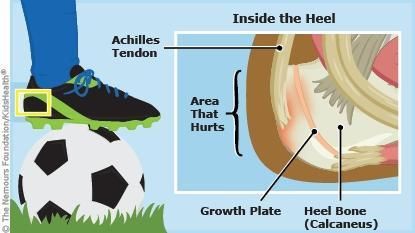Sever’s Disease (calcaneal apophysitis) is a condition that mainly affects growing children, when they’re going through a growth spurt during puberty. Activities like running and jumping cause the already tight Achilles tendon to pull on and irritate the heel bone growth plate, causing pain in the heel.
So, what’s a growth plate? It’s a soft area of cartilage in the heels where bone growth occurs. The Achilles tendon connects the calf muscles to the growth plate in the back of the heel. Because bones often grow faster than muscle, especially in the bones of the foot, the Achilles tendon can become tight.
Sever’s Disease develops when the growth plate in the heel is injured. Sever’s Disease occurs when the growth plate in the back of the heel becomes inflamed due to repetitive stress on the growth plate at the heel bone. It typically occurs during periods of rapid growth, usually puberty, and will occur when activity is increased.
Symptoms
If your child has Sever’s Disease, their symptoms may include walking on their toes (to avoid using their heels), having heel pain with limping, especially after running, swelling and redness around the heel, foot pain or stiffness after sleeping. If your child is involved in sports that involve running and jumping on hard surfaces like athletics, basketball and soccer, and/or wears shoes that don’t support their feet, their symptoms will worsen.
Treatment
Foot doctors will examine your child’s foot, squeezing it at different points to see where it is painful. They may also order an x-ray to rule out other problems, such as a fracture.
- Ice packs or anti-inflammatory drugs such as ibuprofen to relieve the pain
- Supportive shoes and inserts that reduce stress on the heel bone
- Stretching and strengthening exercises
Recovery from Sever’s Disease varies from patient to patient. In most cases, Sever’s Disease goes away on its own with rest, treatment, and time. Make sure your child does not play/exercise through the pain and follows a proper treatment plan.

